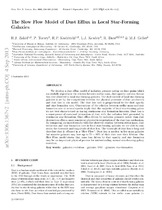| dc.contributor.author | Zahid, H. | |
| dc.contributor.author | Torrey, Paul | |
| dc.contributor.author | Dave, Romeel | |
| dc.contributor.author | Geller, Margaret | |
| dc.contributor.author | Kudritzki, Rolf | |
| dc.contributor.author | Kewley, Lisa J. | |
| dc.date.accessioned | 2017-07-13T13:47:28Z | |
| dc.date.available | 2017-07-13T13:47:28Z | |
| dc.date.issued | 2013 | |
| dc.identifier.citation | Zahid, H. et al. (2013). The slow flow model of dust eflux in local star-forming galaxies. Monthly Notices of the Royal Astronomical Society, 436 (2): 1852-1866 | en_US |
| dc.identifier.issn | 0035-8711 | |
| dc.identifier.uri | http://hdl.handle.net/10566/3072 | |
| dc.description.abstract | We develop a dust efflux model of radiation pressure acting on dust grains which
successfully reproduces the relation between stellar mass, dust opacity and star forma-
tion rate observed in local star-forming galaxies. The dust content of local star-forming
galaxies is set by the competition between the physical processes of dust production
and dust loss in our model. The dust loss rate is proportional to the dust opacity
and star formation rate. Observations of the relation between stellar mass and star
formation rate at several epochs imply that the majority of local star-forming galax-
ies are best characterized as having continuous star formation histories. Dust loss is
a consequence of sustained interaction of dust with the radiation field generated by
continuous star formation. Dust efflux driven by radiation pressure rather than dust
destruction offers a more consistent physical interpretation of the dust loss mechanism.
By comparing our model results with the observed relation between stellar mass, dust
extinction and star formation rate in local star-forming galaxies we are able to con-
strain the timescale and magnitude of dust loss. The timescale of dust loss is long and
therefore dust is effluxed in a “Slow Flow". Dust loss is modest in low mass galaxies
but massive galaxies may lose up to 70 80% of their dust over their lifetime. Our
Slow Flow model shows that mass loss driven by dust opacity and star formation
may be an important physical process for understanding normal star-forming galaxy
evolution. | en_US |
| dc.language.iso | en | en_US |
| dc.publisher | Oxford University Press | en_US |
| dc.rights | Publisher retains copyright. Authors may archive the published version in their institutional repository. | |
| dc.source.uri | https://dx.doi.org/10.1093/mnras/stt1699 | |
| dc.subject | Galaxies | en_US |
| dc.subject | Evolution – galaxies | en_US |
| dc.subject | ISM – galaxies | en_US |
| dc.subject | Star-formation | en_US |
| dc.title | The slow flow model of dust eflux in local star-forming galaxies | en_US |
| dc.type | Article | en_US |
| dc.description.accreditation | Department of HE and Training approved list | |

